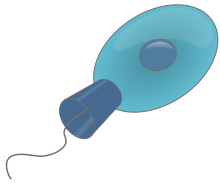| Obazoa | |
|---|---|

| |
| Scheme of a choanoflagellate cell | |
| Scientific classification | |
| Domain: | Eukaryota |
| Clade: | Amorphea |
| Clade: | Obazoa Brown, 2013 |
| Clades | |
|
sister: Amoebozoa | |
Obazoa is a proposed sister clade of Amoebozoa (which together form Amorphea). The term Obazoa is based on the OBA acronym for Opisthokonta, Breviatea, and Apusomonadida, the group's three constituent clades.[1]
Determining the placement of Breviatea and Apusomonadida and their properties is of interest for the development of the opisthokonts in which the main lineages of animals and fungi emerged.[1] The relationships among opisthokonts, breviates and apusomonads are not conclusively resolved (as of 2018), though Breviatea is usually inferred to be the most basal of the three lineages.[2][3][4][5][6]
The phylogeny of the Obazoa is shown in the cladogram.[6][7][8][9]
| Eukaryotes |
| ||||||||||||||||||||||||||||||||||||||||||||||||||||||
| 2200 mya |
YouTube Encyclopedic
-
1/5Views:4061 9038432 100450
-
Opisthokonta | Wikipedia audio article
-
Transitional Fossils Definitely Exist Helping Cindi Lincoln 4
-
Денис Тихоненков. "Проворные Provora: новая группа микробиальных хищников"
-
«Охота на микробов»: новые виды гетеротрофных протистов в прояснении эволюции эукариот
-
Разбор заданий ЗЭ 2019 Биоразнообразие 9 класс
Transcription
References
- ^ a b Brown, M.W.; Sharpe, S.C.; Silberman, J.D.; Heiss, A.A.; Lang, B.F.; Simpson, A.G.B.; Roger, A.J. (2013). "Phylogenomics demonstrates that breviate flagellates are related to opisthokonts and apusomonads". Proceedings of the Royal Society B: Biological Sciences. 280 (1769): 20131755. doi:10.1098/rspb.2013.1755. JSTOR 43601549. OCLC 8093015610. PMC 3768317. PMID 23986111. S2CID 19627175.
- ^ Eme, Laura; Sharpe, Susan C.; Brown, Matthew W.; Roger, Andrew J. (2014). "On the Age of Eukaryotes: Evaluating Evidence from Fossils and Molecular Clocks". Cold Spring Harbor Perspectives in Biology. 6 (8): a016139. doi:10.1101/cshperspect.a016139. ISSN 1943-0264. PMC 4107988. PMID 25085908.
- ^ Ruggiero, Michael A.; Gordon, Dennis P.; Orrell, Thomas M.; Bailly, Nicolas; Bourgoin, Thierry; Brusca, Richard C.; Cavalier-Smith, Thomas; Guiry, Michael D.; Kirk, Paul M. (2015-06-11). "Correction: A Higher Level Classification of All Living Organisms". PLOS ONE. 10 (6): e0130114. Bibcode:2015PLoSO..1030114R. doi:10.1371/journal.pone.0130114. ISSN 1932-6203. PMC 5159126. PMID 26068874.
- ^ Cavalier-Smith, Thomas; Fiore-Donno, Anna Maria; Chao, Ema; Kudryavtsev, Alexander; Berney, Cédric; Snell, Elizabeth A.; Lewis, Rhodri (2015-02-01). "Multigene phylogeny resolves deep branching of Amoebozoa". Molecular Phylogenetics and Evolution. 83: 293–304. doi:10.1016/j.ympev.2014.08.011. PMID 25150787.
- ^ Cavalier-Smith T (2009). "Megaphylogeny, cell body plans, adaptive zones: causes and timing of eukaryote basal radiations". J. Eukaryot. Microbiol. 56 (1): 26–33. doi:10.1111/j.1550-7408.2008.00373.x. PMID 19340985.
- ^ a b Brown, M.W.; Heiss, A.A.; Kamikawa, R.; Inagaki, Y.; Yabuki, A.; Tice, A.K.; Shiratori, T.; Ishida, K.-I.; Hashimoto, T.; Simpson, A.G.B.; Roger, A.J. (2018). "Phylogenomics Places Orphan Protistan Lineages in a Novel Eukaryotic Super-Group". Genome Biology and Evolution. 10 (2): 427–433. bioRxiv 10.1101/227884. doi:10.1093/gbe/evy014. OCLC 7315371047. PMC 5793813. PMID 29360967. S2CID 46757580.
- ^ Schön ME, Zlatogursky VV, Singh RP, et al. (2021). "Picozoa are archaeplastids without plastid". Nature Communications. 12 (1): 6651. bioRxiv 10.1101/2021.04.14.439778. doi:10.1038/s41467-021-26918-0. PMC 8599508. PMID 34789758. S2CID 233328713.
- ^ Tikhonenkov DV, Mikhailov KV, Gawryluk RM, et al. (December 2022). "Microbial predators form a new supergroup of eukaryotes". Nature. 612 (7941): 714–719. Bibcode:2022Natur.612..714T. doi:10.1038/s41586-022-05511-5. PMID 36477531. S2CID 254436650.
- ^ Burki, Fabien; Roger, Andrew J.; Brown, Matthew W.; Simpson, Alastair G.B. (2020). "The New Tree of Eukaryotes". Trends in Ecology & Evolution. 35 (1). Elsevier: 43–55. doi:10.1016/j.tree.2019.08.008. ISSN 0169-5347. PMID 31606140. S2CID 204545629.
